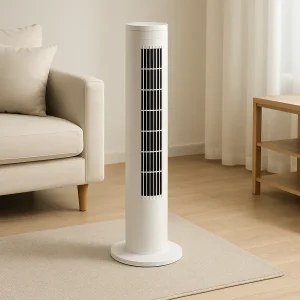Elegir el ventilador adecuado para su espacio puede resultar abrumador. Con tantos tipos de ventiladores, cada uno de los cuales afirma ser eficiente, es fácil cometer un error costoso. Pero cuando el flujo de aire, el ahorro de energía y la rentabilidad son lo más importante, conocer los tipos de ventiladores es la mejor solución.
El tipo de ventilador más eficiente depende de su espacio y finalidad. Para grandes superficies, los ventiladores HVLS y centrífugos son los más eficientes energéticamente. Para viviendas u oficinas, los ventiladores de techo, los ventiladores de torre y los ventiladores de pedestal inteligentes ofrecen una refrigeración eficaz con un bajo consumo energético.

Ventiladores industriales HVLS instalados en el techo del almacén
La eficiencia de un ventilador no sólo depende de la velocidad o de la intensidad de la brisa, sino también de la cantidad de aire que sopla. El aire que puede mover un ventilador con la menor cantidad de consumo de energía. La eficiencia varía en función de:
Aficionados que mover el aire reducir los costes de funcionamiento, mejorar el confort y disminuir el impacto ambiental. Los ventiladores de alta eficiencia también producen menos ruido y duran más si se cuidan adecuadamente.
Medidas clave de eficiencia:
| Característica | Los ventiladores eficientes ofrecen |
|---|---|
| Volumen del flujo de aire | Alto índice CFM para cobertura de espacio |
| Uso de la energía | Bajo consumo o clasificación Energy Star |
| Durabilidad | Motor, rodamientos y carcasa de calidad industrial |
| Control inteligente | Velocidad variable, sensor de movimiento o mando a distancia |
Para tomar una decisión inteligente, es esencial comparar diferentes tipos de ventiladores y su eficacia en aplicaciones reales.
ventiladores centrífugos se utilizan habitualmente en entornos industriales donde es necesario un caudal de aire a alta presión. Estos ventiladores tirar del aire hacia la rueda del ventilador y expulsarlo en un ángulo de 90 grados, creando una alta presión estática, ideal para conductos, sistemas de ventilación, y alta temperatura entornos.
Por qué funcionan mejor los ventiladores centrífugos:
Sin embargo, los ventiladores centrífugos suelen ser más grandes, más ruidosos y más caros que los ventiladores centrífugos. ventiladores de torre o ventiladores de pedestal. Son eficientes en entornos específicos, no para la refrigeración doméstica.
Descubra cómo funcionan los ventiladores centrífugos en grandes instalaciones comerciales
Ventiladores axialespor otra parte, se utilizan ampliamente en muchas aplicaciones, desde ventilador de refrigeración unidades de electrónica a gran escala refrigeración industrial. Funcionan moviendo el aire paralelo al aspa del ventilador y son ideales para situaciones que requieren gran caudal de aire a baja presión.
Los ventiladores axiales tienden a consumir menos energía cuando no están sometidos a cargas de presión, lo que hace que más eficiente energéticamente en espacios abiertos.
Ventiladores de torre son una opción popular en hogares y oficinas debido a su tamaño compacto, diseño moderno y flujo de aire oscilante. Aunque no producen grandes caudales de aire como los ventiladores industriales, sí que circular el aire bien en habitaciones pequeñas y medianas.
Sin embargo, el velocidad del ventilador y la potencia del flujo de aire son limitados en comparación con ventiladores axiales o ventiladores centrífugos. Si elige un ventilador para cubrir grandes superficies como almacenes o gimnasioslos ventiladores de torre no son la mejor opción.

Ventilador de torre delgado para uso doméstico
Ventiladores de pedestal y ventiladores de mesa son flexibles y portátiles, lo que las hace perfectas para la refrigeración temporal o personal. Estos ventiladores eléctricos puede trasladarse fácilmente de una habitación a otra, ajustarse para velocidad del ventiladore inclinada para dirigir el flujo de aire.
Aunque ofrecen un ahorro de energía decente y un control de la dirección del flujo de aire, los ventiladores de pedestal y de mesa no están diseñados para mover grandes cantidades de aire. No son adecuados para entornos que requieran una fuerte y continua ventilación o refrigeración.
Sí-ventiladores de techo siguen siendo una de las mejores formas de circular el aire eficientemente, especialmente en industrial o comercial espacios con techos altos. Su consumo de energía es mínimo comparado con aire acondicionado unidades, y ayudan a mantener aire caliente en invierno y aire fresco moviéndose en verano.
Los ventiladores de techo modernos, especialmente Ventiladores HVLS (gran volumen, baja velocidad), ofrecen una enorme ahorro de energía. Estos Los ventiladores funcionan eficientemente en fábricas, gimnasios, y centros deportivosque ofrece confort con bajos costes de funcionamiento.
Descubra cómo los ventiladores de techo ayudan a refrigerar grandes instalaciones
Ventiladores sin aspas son más silenciosas y seguras, con un diseño futurista que introduce aire en la base y lo empuja a través de un anillo para aire fresco eficazmente. Son ideales para hogares u oficinas que priorizan la seguridad y la estética.
Ventiladores inteligentesya sea torre o pedestalse integran con aplicaciones y asistentes de voz, permitiendo a los usuarios establecer temporizadores, horarios y velocidad de forma automática. Ofrecen comodidad y Eficiencia energética cuando se necesita refrigeración en ráfagas cortas.
Sin embargo, estos ventiladores suelen ser caros y están más indicados para uso personal que para uso doméstico. ventiladores industriales necesidades. Para grandes instalaciones, centrífugo o Ventiladores HVLS siguen siendo las mejores opciones.
Cuando se trata de refrigeración industrialsólo algunos tipos de ventiladores satisfacer la demanda de volúmenes de aire, bajo nivel de ruido, y durabilidad a largo plazo.
Cada tipo de ventilador tiene aplicaciones específicas. Por ejemplo, ventiladores centrífugos manejar alta temperatura, servicio continuo operaciones. Ventiladores HVLS son ideales para refrigeración de su hogar o negocio de forma eficiente sin elevadas facturas de energía.

Ventilador HVLS en un gran almacén
Al seleccionar un ventilador para mover aire en zonas anchas o altas, es importante tener en cuenta diseño de abanico, Aspa del ventilador tamaño y aplicación. Así es como algunos diferentes tipos de ventiladores comparar:
| Tipo de ventilador | Mejor para | Eficiencia | Cobertura |
|---|---|---|---|
| Ventilador de torre | Dormitorios, oficinas | Moderado | Pequeño |
| Ventilador de pedestal | Refrigeración personal | Bien | Medio |
| Ventilador de techo / ventilador HVLS | Almacenes, gimnasios | Excelente | Muy grande |
| ventilador centrífugo | Escape industrial | Alto | Presión alta |
| Ventilador axial | General ventilación | Alto | Amplia zona |
| Ventilador inteligente | Viviendas, oficinas | Bien | Pequeña a mediana |
| Ventilador sin aspas | Seguridad y estilo | Moderado | Pequeño |
Los ventiladores axiales mueven aire en una trayectoria recta, por lo que son ideales para aire acondicionado o necesidades de suministro. ventiladores centrífugos tiran aire hacia el centro y lo expulsan en un ángulo de 90 grados, útil en alta presión, canalizado sistemas.
Ventiladores HVLS (alto volumen, baja velocidad) representan el pináculo de ventilador industrial ingeniería. Estas grandes ventiladores de techo de hasta 6 metros y mover el aire suavemente pero a fondo a través de vastos espacios.
Estos ventiladores no se limitan al caudal de aire, sino que influyen en el rendimiento general de sus instalaciones. consumo de energía, comodidad, y costes de explotación. En comparación con los acondicionador de aire unidades, los ventiladores HVLS proporcionan un mejor retorno de la inversión, especialmente cuando se combinan con controles inteligentes.
Más información: Ventiladores HVLS para aplicaciones comerciales
Un ventilador de bajo consumo saldos flujo de aire con un mínimo uso de la energía. Esto depende de:
Para conseguir ahorro de energíaMuchas empresas pasan de ventiladores eléctricos y acondicionadores de aire a HVLS o ventiladores centrífugos para ahorrar a largo plazo.
Elección de la ventilador derecho depende de su espacio y sus necesidades concretas. Pregunte:
Si gestiona una instalación como un depósito, gimnasia, o fábricala respuesta correcta es casi siempre un ventilador industrial como HVLS o centrífugo tipos.
Cómo seleccionar el mejor ventilador HVLS para su fábrica
¿Qué tipo de ventilador es más eficiente desde el punto de vista energético?
Los más ventilador de bajo consumo es el ventilador HVLS (High Volume Low Speed) para grandes espacios comerciales o industriales. Para entornos residenciales, ventiladores de techo con estrella energética certificación y los motores de corriente continua sin escobillas ofrecen una eficiencia excelente.
¿Cuál es la diferencia entre ventiladores axiales y centrífugos?
Ventiladores axiales mueven el aire en línea recta y son las mejores para mover grandes volúmenes a baja presión. ventiladores centrífugospor el contrario, están diseñadas para generar una mayor presión y son ideales para canalizado o ventilador de escape sistemas.
¿Ayudan realmente los ventiladores a mejorar la eficiencia del aire acondicionado?
Sí. Los fans, especialmente ventiladores de techoAyuda circular el aire y reducir los puntos calientes o fríos. Esto le permite elevar el termostato en verano o bajarla en invierno, reduciendo consumo de energía sin sacrificar la comodidad.
¿Merecen la pena los ventiladores sin aspas?
Ventiladores sin aspas ofrecen seguridad, un funcionamiento silencioso y un diseño moderno. Sin embargo, suelen mueven menos aire que los tradicionales Aspa del ventilador modelos y puede no ser ideal para refrigeración industrial.
¿Qué ventilador funciona mejor para gimnasios o centros deportivos?
Grande Ventiladores HVLS son la mejor opción. Cubren amplias zonas, circular el aire eficientemente, y proporcionar refrigeración sin funcionamiento ruidoso, lo que las hace ideales para instalaciones deportivas.
¿Con qué frecuencia debo realizar el mantenimiento de los ventiladores industriales?
Se recomienda seguir un estricto calendario de mantenimientoComprobación vibración, lubricar rodamientos, inspeccionar motor salud, y limpiar el aspas del ventilador cada 3-6 meses para un rendimiento óptimo.
Para terminar, esto es lo que debe tener en cuenta a la hora de elegir el más ventilador eficiente para tu espacio:
Tanto si gestiona una fábricaequipamiento de un gimnasio comercial, o instalación de ventilación en un depósitoseleccionar el tipo de ventilador garantiza una mayor comodidad y Eficiencia energética.

Hola, soy yo Michael Danielsson, CEO de Vindus Fans, con más de 15 años de experiencia en la industria de la ingeniería y el diseño. Estoy aquí para compartir lo que he aprendido. Si tienes alguna pregunta, no dudes en contactarme en cualquier momento. ¡Crezcamos juntos!